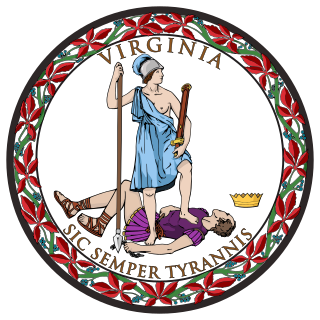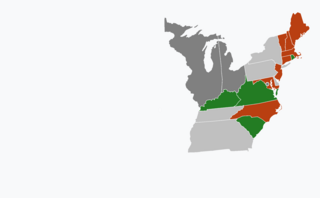A special election was held in Connecticut's at-large congressional district on September 15, 1800 [1] to fill a vacancy left by the resignation of Jonathan Brace (F) in May, 1800.
| Elections in Connecticut |
|---|
 |
A special election was held in Connecticut's at-large congressional district on September 15, 1800 [1] to fill a vacancy left by the resignation of Jonathan Brace (F) in May, 1800.
| Candidate | Party | Votes [2] | Percent |
|---|---|---|---|
| John C. Smith | Federalist | 2,916 | 45.4% |
| Elias Perkins | Federalist | 1,315 | 20.5% |
| Timothy Pitkin | Federalist | 669 | 10.4% |
| Simeon Baldwin | Federalist | 642 | 10.0% |
| Benjamin Tallmadge | Federalist | 365 | 5.7% |
| Calvin Goddard | Federalist | 365 | 5.7% |
| John Treadwell | Federalist | 116 | 1.8% |
| Stephen Hosmer | Unknown | 34 | 0.5% |
Smith took his seat on November 17, 1800, at the start of the 2nd session of the 6th Congress.

The 1802–03 United States House of Representatives elections were held on various dates in various states between April 26, 1802 and December 14, 1803. Each state set its own date for its elections to the House of Representatives, either before or after the first session of the 8th United States Congress convened on October 17, 1803. They occurred during President Thomas Jefferson's first term in office.

The 1800–01 United States House of Representatives elections were held on various dates in various states between April 29, 1800, and August 1, 1801. Each state set its own date for its elections to the House of Representatives before the first session of the 7th United States Congress convened on December 7, 1801. They were held at the same time as the 1800 presidential election, in which Vice President Thomas Jefferson, a Democratic Republican, defeated incumbent President John Adams, a Federalist. Elections were held for all 105 seats, representing 15 states.

The 1798–99 United States House of Representatives elections were held on various dates in various states between April 24, 1798 in New York and August 1, 1799 in Tennessee. Each state set its own date for its elections to the House of Representatives, with some after the official start of the 6th United States Congress on March 4, 1799, but before the start of the first session of this Congress in Philadelphia on December 2, 1799. These elections were held during President John Adams term. It was the last congressional session before the move to the new capital at Washington, D.C. Elections were held for all 106 seats, representing 16 states.

In 1798, the Northwest Territory became eligible to send a non-voting delegate to the U.S. Congress. The Assembly elected this representative.

The 1800–01 United States Senate elections were held on various dates in various states, coinciding with Thomas Jefferson being elected to the White House. As these U.S. Senate elections were prior to the ratification of the Seventeenth Amendment in 1913, senators were chosen by state legislatures. Senators were elected over a wide range of time throughout 1800 and 1801, and a seat may have been filled months late or remained vacant due to legislative deadlock. In these elections, terms were up for the senators in Class 3.

The 1802 United States House of Representatives elections in New York were held from April 27 to 29, 1802, to elect 17 U.S. Representatives to represent the State of New York in the United States House of Representatives of the 8th United States Congress.

The 1804 United States House of Representatives elections in New York were held from April 24 to 26, 1804, to elect 17 U.S. Representatives to represent the State of New York in the United States House of Representatives of the 9th United States Congress. At the same time, a vacancy was filled in the 8th United States Congress.

A special election was held in Pennsylvania's 8th congressional district on January 15, 1801 to fill a vacancy left by the death of Thomas Hartley (F) on December 21, 1800
A special election was held in Massachusetts's 3rd congressional district on December 15, 1800, to fill a vacancy left by the resignation of Samuel Lyman (F) on November 6, 1800.

A special election was held in Massachusetts's 10th congressional district on August 25, 1800 and October 20, 1800 to fill a vacancy left by the resignation of Samuel Sewall (F).
A special election was held in Massachusetts's 4th congressional district on August 25, 1800, and October 20, 1800, to fill a vacancy left by the resignation of Dwight Foster (F) after his election to the Senate, the second election required because the first did not result in a majority.
A special election was held in New Hampshire's at-large congressional district on August 25, 1800 to fill a vacancy left by William Gordon (F) resigning to accept an appointment as New Hampshire Attorney General on June 12, 1800.

A special election was held in Virginia's 13th congressional district on July 31, 1800 to fill a vacancy left by the resignation, on June 7, 1800, of John Marshall (F), who was named Secretary of State by President John Adams.

The 1808 United States elections elected the members of the 11th United States Congress. The election took place during the First Party System. In the aftermath of the Embargo of 1807, the Federalists picked up congressional seats for the first time since their defeat in the 1800 election. However, the Democratic-Republican Party maintained control of the presidency and both houses of Congress.

The 1800 United States elections elected the members of the 7th United States Congress. The election took place during the First Party System, and is generally considered the first realigning election in American history. It was the first peaceful transfer of power between parties in American history. The Democratic-Republican Party won control of the presidency and both houses of Congress for the first time. Conversely, the Federalist Party would never again control the presidency or either house of Congress. Ohio was admitted as a state during the 7th Congress.

United States gubernatorial elections were held in 1800, in 11 states, concurrent with the House, Senate elections and presidential election.